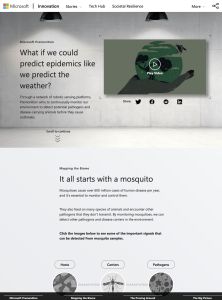
Microsoft Premonition: What if we could predict epidemics like we predict the weather?
Through a network of robotic sensing platforms, Premonition aims to continuously monitor our environment to detect potential pathogens and disease-carrying animals before they cause outbreaks.
Recommendation
What if science could predict disease threats the way it can predict the weather? Mosquitos are responsible for 600 million disease cases a year because they transmit pathogens from the environment to humans. Microsoft’s Premonition project created robotic “smart traps” to lure, capture and analyze mosquito DNA. When networked, these traps can “map the biome” and look for genetic anomalies and potential pathogens, before they reach the human population. To date, Premonition has analyzed 80 trillion base pairs from these environmental samples. Working with industry partners and public health authorities, Microsoft intends to “change the paradigm” from a reactive to a proactive model for tracking threats.
Summary
About the Author
Microsoft Corporation is an American multinational technology corporation that creates computer software, consumer electronics, personal computers, and related services.







Comment on this summary